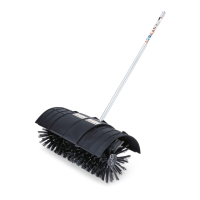KB-KM, KW-KM
English
4
If you use sweeping attachments,
position the gearbox so that the axle is
above the drive shaft.
If you use a shoulder strap or full
harness: Practice removing and putting
down the power tool as you would in an
emergency. To avoid damage, do not
throw the machine to the ground when
practicing.
Replace damaged sweeping
attachments.
See also notes on "Before Starting" in
the instruction manual of the
KombiEngine you are using.
Holding and Controlling the Power Tool
Make sure you always have good
balance and secure footing.
Always hold the power tool firmly with
both hands on the handles.
Right hand on control handle, left hand
on loop handle, even if you are left-
handed.
To ensure safe control, wrap your
fingers tightly around the front handle
and control handle.
During Operation
In the event of impending danger or in
an emergency, switch off the engine
immediately by moving the slide control
/ stop switch/button to 0 or STOP.
To reduce the risk of injury from thrown
objects, do not allow any other persons
within a radius of 5 meters of your own
position. To reduce the risk of damage
to property, also maintain this distance
from other objects (vehicles, windows).
The correct engine idle speed is
important to ensure that the attachment
stops moving when you let go of the
throttle trigger. Check and correct the
idle speed setting regularly. If the
attachment still rotates when the engine
is idling, have your dealer check your
machine and make proper adjustments
or repairs – see KombiEngine instruction
manual.
Electrostatic charges may build up when
working on synthetic surfaces – risk of
electric shock and accidents.
Take special care in slippery conditions
(ice, wet ground, snow), on slopes or
uneven ground.
Watch out for obstacles: Roots and tree
stumps which could cause you to trip or
stumble.
Make sure you always have good
balance and secure footing.
Be particularly alert and cautious when
wearing hearing protection because
your ability to hear warnings (shouts,
alarms, etc.) is restricted.
To reduce the risk of accidents, take a
break in good time to avoid tiredness or
exhaustion.
Work calmly and carefully – in daylight
conditions and only when visibility is
good. Stay alert so as not to endanger
others.

